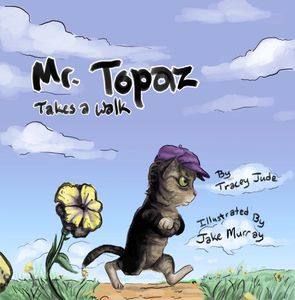Serving schools and families since 2005
Mr. Topaz World of Stories
Mr. Topaz Takes a Walk
Mr. Topaz is Left in Charge
Mr. Topaz is Left in Charge
Mr. Topaz takes a walk when he gets really mad at Miss Tinky. Go with him on his journey to repair his friendship with her. Click image to preview.
Mr. Topaz is Left in Charge
Mr. Topaz is Left in Charge
Mr. Topaz is Left in Charge
Mr. Topaz lives with Sarge. When Sarge leaves he says, "You're in charge!" Go with Mr. Topaz to learn how he copes with loneliness and boredom, and discovers his surprise purpose! Click image to preview.
Mr. Topaz Breaks the Rules
Sensory Treatment Guide and Early Communication
Sensory Treatment Guide and Early Communication
Mr. Topaz left the farm while playing hide and seek. Find out what happens to him on his quest back for home. Click image to preview.
Sensory Treatment Guide and Early Communication
Sensory Treatment Guide and Early Communication
Sensory Treatment Guide and Early Communication
Includes Mr. Topaz Takes a Walk and workbook pages to treat sensory issues and encourage appropriate emotional expression. Excellent for early language development as well. Click image to preview.

What's the Buzz?
Testimonials
- Problemed children are getting younger and younger. There is a need for books like Mr. Topaz. Thank you! - Toni J., Graduate Supervisor, IUPUI
- I work with a second grade, special needs classroom. After just one reading of Mr. Topaz Takes a Walk, the children remembered the problem and recited all the steps to take when they get mad. We were impressed with the details they recalled and expressed. - Marge Z., retired school teacher in public education
- I have a lot of fun reading about Mr. Topaz to my 2 year old. It reminds us both how to calm down. She began to relax by counting to 10, then to 5, and now she only thinks about counting to calm down! She loves Mr. Topaz and readily follows his example to breathe. - Kim R., Parent and Home Educator
Educational Standards
Mr. Topaz supports K-3 curriculum for health and wellness in these and other areas:
- Coping with fear and anger
- Remaining calm
- Considering possibilities
- Serving others
- Asking for help

Supported Research Behind the Series
Findings
- Music's calming effect on the emotional state enables productive learning. Berger & Schneck, (2002).
- Music is regarded as a pre-reading tool with its preliterate and aural qualities. Young children become familiar with music's pattern of sound, aiding to their understanding of language patterns and symbols. Snyder S. (1997).
- Music today brings socioeconomic health tomorrow. Twenty years of eliminating music programs from elementary schools in New York City resulted in violent adults. Furthermore, their children formed new gangs, and reading scores ranked 49th in America. Snyder S. (1997).
- Rhythm is a powerful tool to develop brain functioning and also forecast the need for early attention. Chaotic and random movements of infants during attempts to synchronize with the beat of their parent's movements were characteristic of the movements of older children with autism, learning disabilities, and schizophrenia. Roskam K. (1992).
Sources
- Berger, D. & Schneck, D. (2002). The role of music in physiologic accommodation. In Music Therapy, Sensory Integration and the Autistic Child. Philadelphia: Jessica Kingsley Publishers Ltd.
- Snyder S. (1997). Developing musical intelligence: Why and how. Early Childhood Education Journal, 24(3). 165 - 171.
- Roskam K. (1992). The luxurious anatomical plan: The physiological reasons. In Feeling the Sound: The Influence of Music on Behavior. San Francisco: San Francisco Press.


